
Do you have a question about the Sony DSC-T90/B Cyber-shot® and is the answer not in the manual?
| Model | DSC-T90/B |
|---|---|
| Megapixels | 12.1 MP |
| Sensor Type | CCD |
| Sensor Size | 1/2.3 inch |
| Optical Zoom | 4x |
| Digital Zoom | 8x |
| ISO Range | 80-3200 |
| Internal Memory | 11 MB |
| Battery | NP-BD1 |
| Battery Type | Lithium-ion |
| Camera Type | Compact |
| LCD Screen Size | 3.0 inches |
| Video Resolution | 1280 x 720 |
| Storage Media | Memory Stick Duo, SD/SDHC |
| Weight | 128 g (including battery and memory card) |
| LCD Screen Resolution | 230, 000 dots |
Records model and serial numbers for service inquiries.
Safety guidelines for power, plugs, overloading, and liquid/object entry.
Advice on attachments, cleaning, placement, and environmental factors.
Conditions under which to refer servicing to qualified personnel.
Discourages self-servicing and covers part replacement and safety checks.
Critical safety warnings regarding battery handling and potential hazards.
Information and contact for recycling lithium-ion batteries.
Instructions on the correct orientation and use of the battery charger.
US-specific safety, compliance, and contact information for the product.
Information regarding EU directives, EMC compliance, and potential electromagnetic interference.
Instructions for proper disposal of the product in the EU and other countries.
Guidelines for disposing of batteries correctly to prevent environmental harm.
Specific safety information regarding the UK plug and fuse replacement.
Proper handling and backup procedures for internal memory and Memory Stick media.
Important precautions for recording, handling the camera in various conditions.
Advice on cleaning and potential issues with the LCD screen.
Guidance on using genuine accessories, camera temperature, and overheat protection.
Information on DCF standard and potential compatibility issues with other devices.
Warning regarding unauthorized recording of copyrighted materials.
Sony's disclaimer for compensation due to recording failure or data loss.
Lists all items included with the camera for setup and use.
Instructions on how to use the wrist strap and paint pen.
Notes the incompatibility of this camera with the Cyber-shot Station Cradle.
Identifies buttons, levers, lens, and screen on the camera's top and front.
Identifies the battery cover, tripod receptacle, and connectors on the camera's bottom.
Step-by-step guide to inserting the battery pack into the charger.
Instructions for connecting the charger to the wall outlet and understanding the charge lamp.
Final step to disconnect the battery charger after charging is complete.
Provides estimated times for full and normal battery charging.
Details battery life and the number of images that can be recorded based on media size.
Guidance on using the camera and charger abroad with different voltage supplies.
Step one: opening the cover to access media and battery slots.
Detailed steps for inserting the Memory Stick Duo media correctly.
Detailed steps for inserting the battery pack correctly until locked.
Final step of closing the cover after inserting media and battery.
Lists compatible and incompatible Memory Stick media types for the camera.
Explains how to use and copy images from internal memory when no media is inserted.
Instructions on safely removing Memory Stick media and the battery pack.
Explains how to check the remaining battery charge and notes on its accuracy.
Steps to turn on the camera and start the clock setting process.
Instructions for selecting the desired date display format.
Guide to inputting the specific date and time values using the controls.
Final step to confirm the entered date and time settings.
Instructions on lowering the lens cover and holding the camera correctly.
How to press the shutter button halfway to achieve focus and AE/AF lock.
The final step of pressing the shutter button fully to take the picture.
How to press the playback button to view the last taken image.
Instructions for selecting the next or previous image on the screen.
Steps to delete the currently displayed image using the on-screen options.
How to exit playback and return to shooting mode.
Methods for turning off the camera, including closing the lens cover.
How to select the Easy Shooting mode for simplified settings and larger text.
Guide to changing Self-Timer, Image Size, and Flash settings within Easy Shooting.
How to return to the normal Intelligent Auto Adjustment display.
How to select and activate the Smile Shutter mode.
Explanation of how the camera automatically shoots when a smile is detected.
Tips for achieving better smile detection, focusing on eyes and mouth visibility.
How to select Scene Recognition mode for automatic scene detection.
Explanation of how the camera identifies scenes and displays corresponding icons.
Guide to focusing and shooting once the scene is recognized.
Details on the 'Advanced' setting that captures two shots with different effects.
How to enable Macro mode for close-up photography.
Instructions for using the self-timer with 10-second or 2-second delays.
Explanation of various flash modes like Auto, Flash On, Slow Synchro, and Flash Off.
Notes on when certain flash modes are unavailable, such as in Intelligent Auto Adjustment.
How to change the screen display between Normal, Simple, and Image Only.
How to access and interpret the histogram and adjust screen brightness.
How to touch a specific point on the screen to set the focus.
How the camera detects and prioritizes focusing on faces, with options for auto, child, or adult priority.
Guide to selecting image sizes based on intended use like printing or email.
Notes on how different aspect ratios (4:3, 16:9) are displayed on the LCD.
Table showing the number of still images recordable based on size and media capacity.
Lists various scene modes like ISO, Gourmet, Soft Snap, Landscape, etc.
How to select and use different scene modes for optimal shooting conditions.
Steps to select Movie Mode and start/stop recording video.
How to use playback controls to view recorded movies.
Details on different movie sizes, average bit rates, and usage guidelines.
Table showing approximate maximum recording times for movies based on size and media.
How to enlarge images and adjust the zoom scale and position.
How to display images full-screen and exit the wide zoom mode.
How to temporarily rotate vertical images for viewing.
How to start, view, and end a slideshow with music.
Instructions for transferring music files to use as background music for slideshows.
How to use the Image Index to browse and locate images.
How to select different display formats like Date View, Event View, Favorites, or Folder View.
Details on how Date View, Event View, Folder View, and Favorites organize and display images.
How to delete the currently displayed image.
Steps to select and delete multiple images using the Image Index.
How to delete images by date range, event, or folder.
How to access the format function from the Manage Memory menu.
Step to confirm the format operation, which erases all data.
How to connect the camera to a standard TV for viewing images.
How to connect the camera to an HDTV for high-definition viewing.
Steps to connect the camera to a PictBridge-compliant printer for direct printing.
Information on printing at shops, home, and superimposing dates using software.
Introduction to the PMB software for managing and enjoying images.
Overview of media services, calendar viewing, printing, and CD/DVD burning with PMB.
How to export images to a Memory Stick Duo media for viewing on the camera.
Specifies the recommended computer environment for installing PMB and Music Transfer.
Step-by-step guide for installing the PMB software from the supplied CD-ROM.
Steps to connect the camera and import images using the PMB software.
Instructions on how to open and view the PMB Guide for detailed information.
How to copy images to a Macintosh computer and view them in Folder View.
Recommended computer environment for importing images and using Music Transfer on Mac.
How to adjust or disable camera operation sounds like shutter and beep.
Explanation of the HOME screen layout for accessing shooting, viewing, and printing functions.
Covers beep sounds, function guide, initialization, housing mode, and demo mode.
Covers AF Illuminator, Grid Line, Digital Zoom, Auto Orientation, and Auto Review.
Covers Clock Settings and Language Setting.
How to navigate and use the camera's menu system.
Details on Image Size, REC Mode, EV, ISO, White Balance, Focus, etc.
Options for Date List, Event List, View Mode, Filter by Faces, Slideshow, Retouch, etc.
How to adjust Focus, Metering Mode, ISO, and EV in Program Auto mode.
Explains icons displayed during still image shooting, like battery, zoom, and Scene Recognition.
Explains icons shown during movie shooting, like zoom, View Mode, and Face Detection.
Explains icons shown during playback, like image size, SteadyShot, and recordable images.
Instructions for accessing the Cyber-shot Handbook on Windows computers.
Instructions for accessing the Cyber-shot Handbook on Macintosh computers.
Basic steps to resolve camera issues, including checking the handbook and initializing settings.
Solutions for issues like not inserting the battery, camera not turning on, or sudden power off.
Troubleshooting incorrect battery indicators and charging problems.
Solutions for when images cannot be recorded, including memory capacity and flash issues.
Solutions for problems encountered when trying to play back images.
Warnings about storing and handling the camera in various environments and conditions.
Guidelines for cleaning the LCD screen, lens, and camera surface.
Information on operating temperatures, moisture condensation, and backup battery charging.
Details on image device, lens, exposure control, recording media, and LCD panel.
Covers power sources, operating/storage temperatures, dimensions, mass, and compatibility.
Technical details for the BC-CSD battery charger and NP-BD1 battery pack.
Lists trademarks related to Sony products like Cyber-shot and Memory Stick.
Lists trademarks for software and hardware from Microsoft, Apple, and Intel.

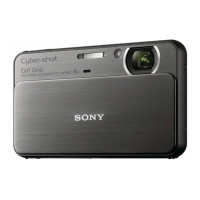


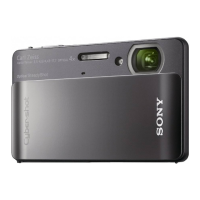



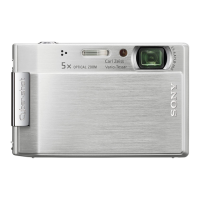
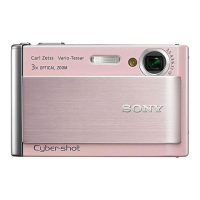
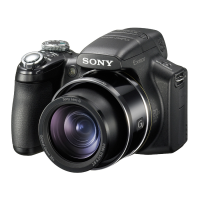
